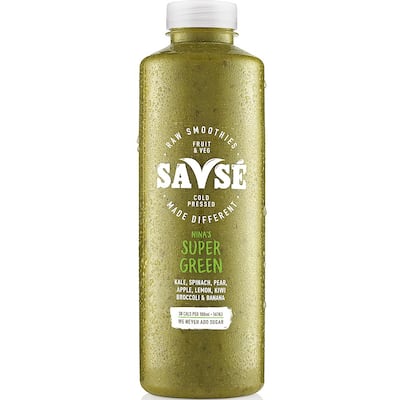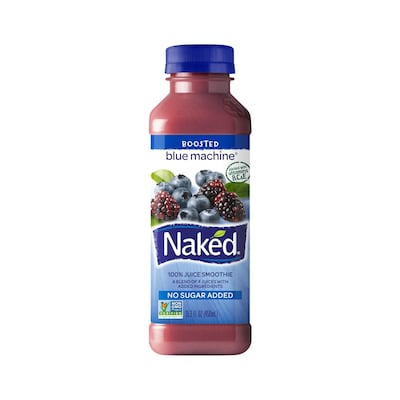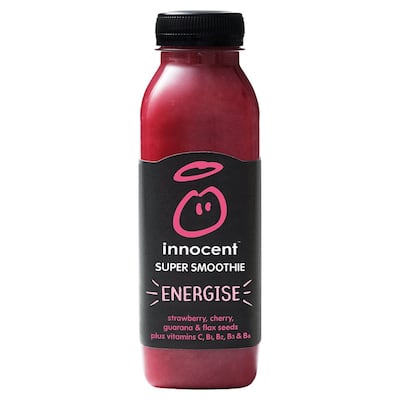When looking to hydrate while out and about, the best drink to turn to is water. But even the sparkling version is a bit boring. There are far more enticing options to be had, although the market seems to be dominated by Coca-Cola and Pepsi, even if you choose a smoothie.
That’s because two of the most popular smoothie brands on sale here are owned by those multinational giants. Coca-Cola owns Innocent and Pepsi owns Naked. That information isn’t on the labels, unless it is in invisible ink or so tiny I couldn’t read it. The other common brand is Savsé, a small British outfit, and there are a few Irish ones, too, as well as supermarket own brands.

What is on the label on most smoothies follows the usual formula of marketing spin on the front and information on the back. Now that the public has cottoned on that the term “superfood” is simply a marketing ploy, that word appears seldom.
And yet, there it is on the front of the Naked Blue Machine Superfood Apple, Blackberry and Blueberry Smoothie. It also proclaims “only natural sugar”, which is helpful given that the traffic light for sugar on the front is red, indicating that it is high in sugar. This drink has 17g in each 150ml serving. This means a “serving” is about the size of one of your granny’s little old-fashioned cups and it contains about four teaspoons of sugar. This is why some bottles say, “One of your five a day” because it is not advisable to take more than that. Meanwhile, the standard tiny bottle from all brands is 250ml.
Cola comparison
Most of the smoothies from Innocent and Naked have more sugar than do cola drinks, hence the many headlines proclaiming that news recently. Most Innocent and Naked smoothies have exactly 11g per 100ml, whereas Coco-Cola has 10.6g. But that is unfair to other brands such as Savsé, whose Super Green Broccoli, Pear, Spinach and Kale smoothie contains just over 7g per 100ml. The yummy Happy Pear Green Lunch smoothie has just 4.6g of sugar per 100ml.

It is odd that so many smoothies have the same percentage of sugar despite the huge variety of fruit and flavours available.
Perhaps the answer lies in the ingredients.
Turn over the Naked Blue Machine and you will see it’s overwhelmingly apple juice and banana puree. You will also see that what makes it “super” is probably the added vitamins. It has: apple juice (70 per cent), banana puree (18 per cent), blackberry puree (5.5 per cent), blueberry puree (4.9 per cent), natural flavourings, blueberry and carrot concentrates, vitamins C, E, B6, B12, niacin and pantothenic acid.
Juices made with puree taste like liquid jam – and why the company needs to add mystery flavourings to make fruit taste better is beyond me. B vitamins can help to turn food into energy. Niacin is another word for vitamin B3 and panthothenic acid is vitamin B5.
Super?
Smoothies that don’t use the word “superfood” often just stamp the world “super” on the front for no discernible reason. So, for example Innocent has a range of Super Smoothies including Energise. Look at Energise and you will see where it gets its name and why you should not drink it at night.

Its ingredients include: 1½ pressed apples, 14 red and white grapes, three-quarters of a mashed banana, 3½ crushed strawberries (10.5 per cent), four crushed cherries (4 per cent), nine crushed blackcurrants, a dash of beetroot juice, some milled flax seeds (0.6 per cent), a dash of guarana infusion (0.01 per cent) and some vitamins (B1, B2, B3, B6 & E).
Firstly, a lot of fruit has a high reading on the glycaemic index – in other words, it will give you a quick boost – such as grapes. Secondly, the guarana is generally sold as a stimulant and it has a high caffeine content. Thirdly, there are added B vitamins, for energy.
A lot of smoothies are just sugary, expensive apple juice drinks.
It’s a good idea to make sure you have fruit in your diet, but best to eat it rather than drink it. Or if you want a smoothie, make your own.
Supermarkets now sell packets of frozen fruit that can be whizzed up in minutes and you don’t have to use apples unless you want to.
FOOD LABELS SERIES
1) Being a successful shopper
2) Bread
3) Milk
4) Cereal
5) Rashers
6) Yoghurt
7) Soup
8) Hummus
9) Pasta sauce
10) Chinese ready meals
11) Frozen chips
12) Chilled fish
13) Egg
14) Chicken Kiev
15) Crisps
16) Mayonnaise
17) Baked beans
18) Tomato ketchup
19) Chocolate digestive biscuits
20) Avocados
21) Cadbury's Dairy Milk
22) Dark chocolate
23) Salad Cream
24) Pesto sauce
25) Smoothies
26) Sliced ham
27) Vanilla ice cream
28) Ice-pop
29) Jaffa cakes
30) Protein bars
31) Energy bars
32) Chicken Tikka Masala
33) MiWadi
34) Peanut butter











